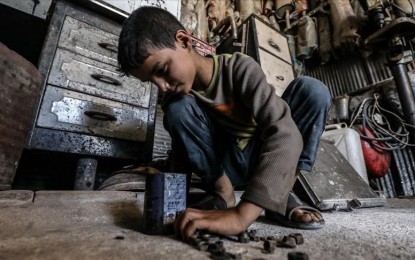
CHILD LABOR. Africa tops the list of countries with high child labor cases followed by Asia and the Pacific. Records showed that one in five children (92 million) worked as child laborers. (Anadolu)
ANKARA – Globally, nearly one in 10 children works as a "child laborer," while in the least developed countries, this ratio corresponds to more than one in five children.
According to information compiled by Anadolu from the International Labor Organization (ILO) and UNICEF on the occasion of the World Day Against Child Labor on June 12, approximately 160 million children (63 million girls and 97 million boys) are still engaged in child labor worldwide.
This figure corresponds to one in 10 children globally, with the number of child laborers increasing in the least developed countries. Sub-Saharan Africa has the highest incidence of child labor at 26 percent, while 7 percent of children in Latin America and the Caribbean work in hazardous jobs.
In the least developed countries, more than one in four children between the ages of five and 17 work in jobs that are considered harmful to their health and development. When considering the population sizes of countries worldwide, the number of child laborers, around 160 million, exceeds the population of all but eight countries.
Africa ranks top in child labor
According to a report published by the ILO and UNICEF in 2021, Africa tops the list with one in five children (92 million) working as child laborers. Asia and the Pacific rank second at 5.6 percent of children (49 million) engaged in child labor in this region.
Moreover, there are 8.3 million child laborers in the Americas, 8.3 million in Europe and Central Asia, and 2.4 million in Arab countries. While Asia and the Pacific, as well as Latin America and the Caribbean, have made steady progress in combating child labor since 2008, the situation has worsened in Sub-Saharan Africa.
Working children face risks such as physical and psychological harm, disruption of their education, deprivation of basic rights, and missed opportunities for their future.
Furthermore, the number of children aged five to 17 working in jobs defined as hazardous to their health, safety, or morals has increased by 6.5 million since 2016, reaching 79 million.
During the 16-year period starting in 2000, there has been a net decrease of 94 million in the number of children engaged in child labor, while the number of children working in hazardous jobs has decreased by more than half.
Agriculture sector stands out
The agricultural sector constitutes the largest share of child labor, accounting for 70 percent (112 million children) of all child labor.
Furthermore, 31.4 million children are engaged in child labor in the services sector, while the number is 16.5 million in the industrial sector.
Some 48 percent of child laborers are between the ages of five and 11.28 percent are between 12 and 14, and 25 percent are between 15 and 17, with a significant portion of those engaged in hazardous jobs being children aged 5 to 11.
The rural child labor rate is 14 percent, while around 5 percent in urban areas. Moreover, 28 percent of child laborers aged 5 to 11 and 35 percent of those aged 12 to 14 do not attend school.
Some 72 percent of child laborers work with their families and they can also be found in hazardous jobs. Furthermore, the data reveals that the proportion of boys among working children is higher than that of girls in all regions and age groups. (Anadolu)
